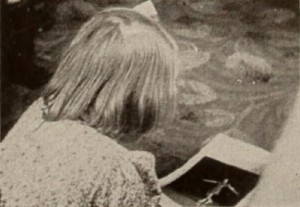
"Victor E. Pye, using his family as the principal actors in a sincere and competent photoplay, brings us the flavor of family life in far away Australia. With a sure cinematic sense, he opens Inspiration with a moving dolly sequence which carries you into the house directly to the star of the film. With creditable economy of footage and compelling acting and directing, Mr. Pye tells a simple tale of a once crippled child returned to health through the inspiration of a famous figure skater — herself a former "polio" victim. There are also several scenes from which it becomes obvious that the movie maker has profited from viewing theatrical productions with his mind on his own filming. Suave and sensitive, Inspiration becomes moving and believable as the plot unfolds." Movie Makers, Dec. 1946, 488.
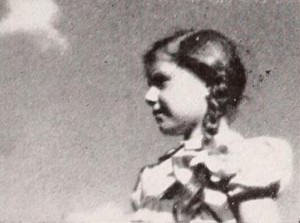
"These Third Avenue kids, see, are playing hide and seek around the front stoops and dark doorways of their native block, when one of them — a little girl — huddles thoughtlessly into the back seat of a parked and beckoning car. Her adventures, when the car is then driven off by a gay young pair of picnickers, comprise the story of Kid-Napped! by Victor Ancona. It is a dramatic story, full of suspense and impending tragedy, but it is one, happily, which refuses ever to take itself too seriously. The young man and his lady pass a bright day in the country with their sandwiches, soda pop and jazz music on a portable radio. The little girl — whom chance dictates shall not be discovered by the picnickers until near the film's end — wanders in happy wonder from flower to fern, from bird song to lakeside. These parallel themes — interspersed with occasional dramatic flashes of a frantic mother — are developed by Mr. Ancona in a suave combination of imaginative camera viewpoints, striking manipulation of outdoor lighting and competent cutting. An 8mm. production, Kid-Napped! eschews, with brilliant selectivity, the unsatisfactory long shot, to present the medium at its best." Movie Makers, Dec. 1944, 494.
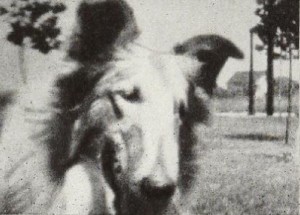
"Children and pets are generally lovable and always interesting; but filming them is not a simple task, as many amateurs have found out. Raymond J. Berger, in Lassie Stays Home, accomplishes it with a sure touch and an ease that will be the envy of his fellow filmers. The excellently planned story tells of a lost child who is found by Lassie, the loyal canine family member, after the baby's somewhat older sister hunts her frantically. No adult appears in any of the footage; and remarkably enough, one does not sense the directing mother, just out of camera range. The whole movie goes forward as if the children and Lassie were entirely alone, with the camera miles away. Here is 8mm at its best and here is a film that every amateur would be proud to have made." Movie Makers, Dec. 1945, 494.
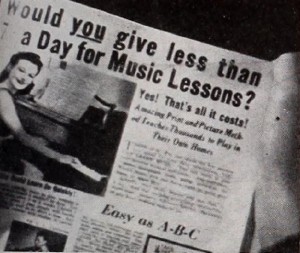
"Lend Me Your Ear is an almost perfect synthesis of shrewd planning, impeccable camera work, smoothly integrated music and general, overall charm. It is gay, glamorous and in good taste. In it, Erma Niedermeyer has caught the lighthearted spirit of 'teen aged American youth. That she was amply aided by her own attractive son was her further good fortune. As the film opens, the Boy is discovered musing over that classic advertisement which guarantees to teach you piano in ten easy lessons. "You too can be the life of the party!" it clarions. The Boy answers the call, the lessons start arriving and the fun begins. There is the light "running gag" of the harried postman, continually overwhelmed by the Boy's enthusiasm as he delivers each new installment; there is the time the piano refuses to play, clogged up as it is by a basketball in its "innards"; there is the tousle headed imitation of Franz Liszt at the age of fourteen — and more. There is, in climax, the Boy's devastating triumph amid a bevy of admiring beauties, as he becomes in truth "the life of the party." Geared to these sequences — which are presented in swift pace and with unerring command of the camera — is a musical accompaniment as suave as the film itself. A single commercial recording provides a slight and recurring background theme. All the remaining score — from the first hesitant scales to the final rocking rendition of a jazz hit — is in the Boy's own playing, especially recorded by Mrs. Niedermeyer to fit her own picture. It is an ineffable and irresistible combination, this Lend Me Your Ear, warmly deserving of the high honor it has won." Movie Makers, Dec. 1943, 457.

"'Life,' by H. B. Hutchings, given the highest recognition for Home Movies, is the sort of picture that the 16mm camera was made for. It is a day in his son's life and contains many effects which were undoubtedly secured with one of the more modern cameras." American Cinematographer, Dec. 1933, 321, 342.

"This year, Ten Best welcomes a baby picture to its select circle. Out of the large number of personal and family films submitted to the League, Linda represents the ultimate in child movies. Here, in less than ten minutes of running time, unfold some of the high lights of the first few weeks of a baby's life. Following a carefully planned scenario, Richard Fuller shows himself well acquainted with motion picture technique. Lovely settings are accentuated by superb lighting. Pastel pinks and blues, colors intimately connected with the nursery, predominate. Fine cutting, well chosen camera viewpoints, effective use of dolly shots and double exposures all attest to a sound knowledge of cinematic expression. Above all, there is a feeling of quality and good taste. At the advent of a tiny stork, ingeniously controlled by wires, Mr. Fuller begins pacing the floor and lighting one cigarette after the other. Then, the routine of Linda's early days is set forth in charming fashion." Movie Makers, Dec. 1941, 564.
"A family picture built around the young daughter of Ira Radovsky. She is coming into the age when little girls want to go for a walk when things at home are not completely as they would like them. We follow the adventures of this young lady and enjoy every moment of it." PSA Journal, Nov. 1958, 46.
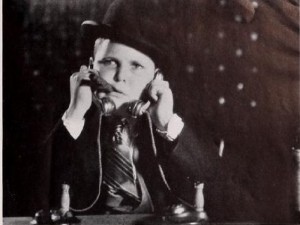
"In Little Geezer, running 400 feet, Theodore Huff, ACL, has produced one of the most able and amusing burlesque film stories of the amateur year, repeating his success of that earlier satiric classic, Hearts of the West. Again he has used, with amazing directorial facility, the neighborhood youngsters as his only actors. Again he has aped, with his own peculiar genius, the threadbare cliches of professional drama, poking fun in his filming as well as his titling. Little Geezer offers fine examples of real cinema, is the sort of thing amateurs can do as well or better than professionals and is delightfully amusing in the process." Movie Makers, Dec. 1932, 561.
"Theodore Huff, ACL, has done it again! That lone wolf producer of Hearts Of The West has paralleled the gorgeous fun of his earlier panning of the purple plains as he takes the gangsters for a ride in Little Geezer. The Big Shot, his lieutenant, Greta Garbage (" — more to be pitied than sniffed at") and Scarface Macaroni are all there, played by the neighborhood kids, no one of them over eleven years old. Through their naively serious acting and his own genius at direction and editing. Mr. Huff has riddled with bursts of laughter the machine gun monarchy of professional filmdom." Movie Makers, Sept. 1932, 398.
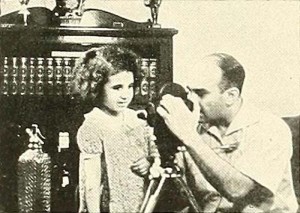
"Already well in the forefront of contemporary photoplay producers, Charles J. Carbonaro has taken a marked step onward in his current comedy, Little Sherlock. Simply planned yet smoothly integrated, this new production tells a delightful tale of the precocious daughter of a photographer, who was always "helping" father. How, during a surprise robbery of their home, she records the crux of the event with Daddy's amateur movie camera provides a denouement which is both satisfying and successful. In Little Sherlock, Mr. Carbonaro has more than maintained the suave lighting and impeccable technical standards for which his work is known; he now wins new honors with a display of genuine talent for light comedy direction. To both of these credits must be added praise for his own acting of the busy cameraman and for the portrayal of the eager apprentice by his own daughter, Alice." Movie Makers, Dec. 1937, 603.
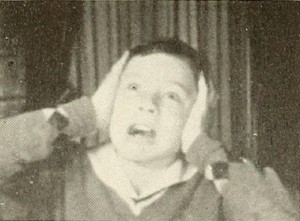
"The plot of Magic Mush is one that is fairly familiar to movie makers. A youngster saves up enough of the coupons that come with a breakfast food to get a free magic set, complete with wand. It turns out that the magic wand actually works, and Sister and Brother make things appear and disappear to their hearts' content. The trick work involved is done by stopping the camera, removing some article from the scene, or adding one to it, and starting the camera again. To this familiar plot, Eric N. Unmack has added some clever ideas of his own. One amusing device is the return of a kitten, rescued from the limbo of magic; she comes floating down, tied to a small parachute. Other clever tricks and especially good acting make this a first class family reel. All of it is presented with uniformly excellent interior filming." Movie Makers, Dec. 1941, 566.
Total Pages: 12